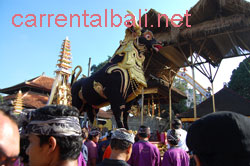Bali Car Rental Blog
Ceremonies in Bali Island
11 February 2011Religious ceremonies in Bali , which are integral to the thinking and attitudes of the Balinese, continue as frequently and as importantly as ever, and remain relatively unchanged over the years in spite of modernization trends. Children from work in order to participate in these ceremonies. Balinese regularly perform a multitude of ceremonies which occupy a relatively large portion of their time and effort, consume a substantial portion of their savings, and are of great significance to their lives.
A number of scholars have described many of these in detail (Belo, 1953; Boon, 1977; Covarrubias, 1937; Hooykaas, 1977; and Moerdowo, 1973). Ceremonies usually involve the extended family, one's own banjar, or the entire desa. Some, such as panca wali karma at the mother temple Besakih , involve all of Bali ; during one month in every 10 years, cars, trucks, and buses bring people of all ages to pray and make offerings. Almost all ceremonies involve the participation of many people. Generally, both men and women take part and their roles are separate. For example, women make the banten and other offerings, and help prepare and serve food. Men prepare much of the food to be cooked for feasts, organize and arrange the procedure for the ceremony, attend to the construction of all effigies and special buildings for the occasion, make costumes for the dances, arrange and repair orchestral instruments, and manage the logistical problems which must be dealt with in order to ensure success.
Most ceremonies and Bali dances take place in and around the temple structures, as is strikingly evident to visitors to Bali . There are more than 10,000 temples in Bali , all of which serve a variety of purpose (includes those of the family, the state, rice fields, cemeteries, and the sea). The village temples are large enough to accommodate almost the whole community at a single ceremony. Temples are walled-in, open air areas containing several small pavilions and shrines. Persons of all status, including the poorest families, are free to participate in community festivals and temple ceremonies.
 An important group of ceremonies relate to the individual's life cycle (manusa yadnya). Each milestone in this cycle is marked by a ceremony, the purpose of which is to expiate past wrong deeds and thereby achieve greater perfection in this life, as well as in future lives. These ceremonies area conducted at birth, at the separation and burial of the placenta, at seven days of age, at one month, at one month and seven days, at three months, at six (otonan). Other milestone ceremonies occur at the loss of deciduous teeth, at menarche, at adolescence (e.g. tooth filing, now a token filing procedure to bring the upper teeth into a straight line in order to diminish the six evil qualities of human nature: anger, desire, greed, jealousy, irresoluteness, and intoxication), at marriage and death (e.g. ngaben, which includes cremation and ngrorasin, which is held twelve days after death), and at unification with God (ngukur or mligia). An elective mile stone in life is the preparation (culminating in the pawintenan ceremony) to become a holy person: one who vows celibacy, is instructed in a certain diet (e.g. vegetarian), and participates in other rituals in order to remove bad thinking and better serve God and the gods. This preparation is not the same as that for a priest.
An important group of ceremonies relate to the individual's life cycle (manusa yadnya). Each milestone in this cycle is marked by a ceremony, the purpose of which is to expiate past wrong deeds and thereby achieve greater perfection in this life, as well as in future lives. These ceremonies area conducted at birth, at the separation and burial of the placenta, at seven days of age, at one month, at one month and seven days, at three months, at six (otonan). Other milestone ceremonies occur at the loss of deciduous teeth, at menarche, at adolescence (e.g. tooth filing, now a token filing procedure to bring the upper teeth into a straight line in order to diminish the six evil qualities of human nature: anger, desire, greed, jealousy, irresoluteness, and intoxication), at marriage and death (e.g. ngaben, which includes cremation and ngrorasin, which is held twelve days after death), and at unification with God (ngukur or mligia). An elective mile stone in life is the preparation (culminating in the pawintenan ceremony) to become a holy person: one who vows celibacy, is instructed in a certain diet (e.g. vegetarian), and participates in other rituals in order to remove bad thinking and better serve God and the gods. This preparation is not the same as that for a priest.
There are many general ceremonies related to time according to the Balinese calendar (e.g. galungan and kuningan). In a six- month period there are at least five tumpek ceremonies. The purpose of tumpek landep to give thank for all material things made from metal; tumpek uduh, for plants, tumpek andang or tumpek uye, for animals; tumpek wayang, for puppets; and tumpek kuningan, for the well-being of the world and its contents.
In addition there is the full moon ceremony (purnama), as well as the ‘dark moon' ceremony (tilem); kajeng kliwon, which comes every fifteen days, is potentially fearful time because on this day the evil spirits abound and persons with bad intentions may easily be possessed and, in turn, disturb others. Persons with mental illness generally date the onset of their symptoms to this day.
The ceremony of nyepi marks the new year, according to the Balinese Isaka calendar and occurs approximately every 364 days, usually in March. At Nyepi holiday, all fires are extinguished, both literally in the real world and figuratively in hearts that are malevolent. By participating in this day of silence, the Balinese hope to restore inner peace. The day preceding Nyepi is even more important. Exorcist rituals of great power are conducted, and these are made more serious by the Balinese notion that for the past five months there have been an unusual number of dangerous demons roaming the villages causing illness, crop failure, and other disasters. The mecaru ceremony is performed with offerings and sacrificies (such as s chicken duck, or cow) to placate the demon deities (buta kala). The Ngrupuk ceremony is held to appease all evil spirits which surround their homes, family, and members of the banjar and desa so that they will leave and peace will again prevail.
The ceremonies of galungan (every 210 days) and Kuningan (the tenth days after Galungan) are major events celebrating man's victory over evil such as anger, jealousy, thievery, and violence. On these festive occasions, there are many colorful ceremonies thought-out Bali island which are easy for the to encounter and attend because they are marked by processions of brightly clothed, traditionally dressed people, accompanied by gamelan orchestras, walking along the road or crowding around roadside temples.
The ceremony of Saraswati is held to thank the goddess of knowledge; pagerwesi, to make offerings to God for providing welfare and giving happiness to the world and all its contents; and Siwalatri, to give thanks to Siwa for the dissolution of sins, such as being angry at a parent or failing to make an offering to the gods.
Offerings to the gods and God are a part of every ceremony. They usually contain flowers and betel-nut arranged in a small tray made of woven young palm leaf (banten) along with incense smoke (dupa), and holy water (tirta), accompanied by a high priest's mantera (i.e. holy chanting to call the gods and God). Other offerings for ceremonies include not only banten but also aesthetically arranged baskets or stacks of fruit, eggs, chicken, or duck, which women usually carry on their heads to the temple.
In addition to the general community-wide and individual ceremonies, there are many other ceremonies such as those at home, at a banjar, at an anniversary of the construction or repair of a local temple, and even at a specific temple on the grounds of the mother temple at Besakih.
But at the new year, these same roads are empty, stretching up and down the frequent hills, between terraced fields holding green rice, to another district where the rice is golden, on to a third where the rice is so young that the flooded beds seem filled mostly with reflections from the sky. The air on every other day of the year is filled with sound, high staccato voices shouting the clipped ambiguous words of familiar speech or artificially prolonging the syllables of polite address, quips of passers-by to the vendor girls who make a professional art of repartee, babies squalling on hips of their child nurses; over and above and behind all these human sounds, the air on other days carries music from practicing orchestras, from an individual idly tapping a single met allophone, from children with jew's-harps, and from whirring musical windmills set on narrow standards high against the sky. On feast days, the roads are crowded with processions of people in silks and brocades, walking in easily broken lines behind their orchestras and their gods; gods represented by images made of leaves and flowers; gods which are masks or bits of old relics. With the processions mingle groups of people grimed from work, hurrying lightly beneath heavy loads; and theatrical troupes, their paint and fine costumes tucked away in little bundles, trudge wearily behind the two-man mask, the patron dragon (barong) who walks quietly with covered face.
To this may be added the heady images of roadside procession comprising a group of 30 or more men in chorus singing long melodious chords, interspersed with a band of body-resonating giant gongs, throbbing drums, and cymbals; a small forest of colored tassel-rimmed parasols high above the crowds; long lines of women carrying intricately arranged offerings stacked on their heads, with one occasionally appearing to go spontaneously into trance and possession by the gods while still miraculously maintaining the balance of the offering on her head; people sitting on the temple grounds raising their hands in prayer as the priest casts holy water over them; crowds of people milling about in the gathering darkness, lit only by lantern and moonlight; all seemingly happening at once, raising the emotions to a heightened and sustained level. Trance rituals and ceremonies play a significant and enduring role in dealing with evil spirits and witchcraft. In some villages, almost the whole populace can go into trance at certain ceremonies. However, there are individuals who do not experience trance. Trance and possession states in ritual and dance are socially approved, facilitated, and controlled. McPhee (1946), an observer of trance and possession phenomena in the 1930s that exist today in the same manner and form, avidly described one such occurrence:
While, from the shadows, there came the sound of animated music from the gamelan, a group of women stepped forth to dance the gabor, the presentation of offerings of wine, oil, incense. Their shoulders were bare; their breasts bound with woven scarves, and in their hair were crowded orchids, jasmine, gardenias.
It was close down when, in the now almost deserted courtyard, the priestess fell once more in trance. In a hoarse, exhausted voice she announced the presence of the god. It was the god now speaking. There was a pause. The god called attention to the poor condition of the temple. It was in need of repair. Another pause, the priest now asked advice about certain village affairs. What must the offerings be for the next feast? Back and forth the voices went, until at last the priestess grew silent and would talk no more. In the dim light of early morning she woke, looked dazedly around, and we knew the gods had left.




